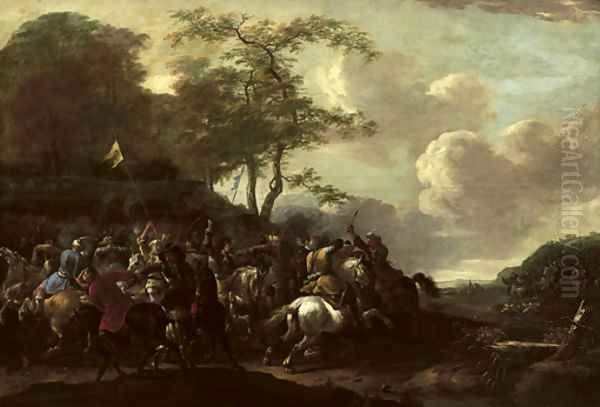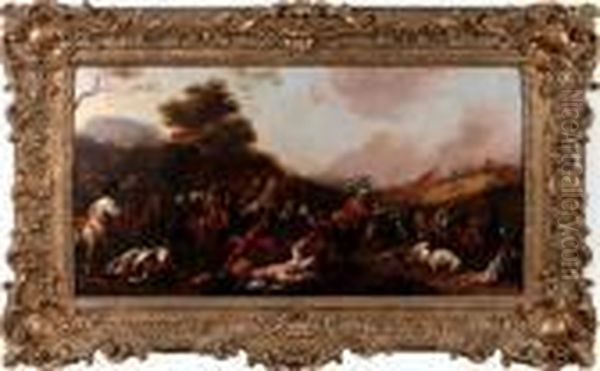Simon Johannes van Douw stands as a notable, albeit sometimes enigmatic, figure within the rich tapestry of 17th-century Flemish art. Active primarily during the mid-to-late decades of the century, a period often overshadowed by the giants of the earlier Flemish Baroque, Van Douw carved a niche for himself as a skilled painter and draughtsman. He is particularly recognized for his dynamic and detailed depictions of battle scenes, cavalry skirmishes, and equestrian subjects, often set within carefully rendered landscapes that betray the influence of contemporary Italianate painters. His base in Antwerp, a major artistic hub, placed him firmly within the traditions of the Southern Netherlands, yet his work also reflects broader European artistic currents.
Origins and Active Period
Pinpointing the exact biographical details of Simon Johannes van Douw presents some challenges, a common issue with artists of this era who were not of the absolute first rank. He is generally believed to have been born around 1630. His place of birth is not definitively recorded, but his professional life is strongly associated with Antwerp. His period of activity is documented from the mid-1650s onwards. Sources suggest he was active until at least 1677, which is often cited as his year of death. However, some records indicate activity potentially extending later, possibly into the 1680s or even 1690s, leading to some ambiguity regarding his precise lifespan, with some accounts suggesting a death date after 1677 but before 1697. Regardless of the exact dates, his career unfolded during the latter part of the Dutch Golden Age and the continuing vibrancy of the Flemish Baroque tradition.
Antwerp and the Guild of Saint Luke

Van Douw's professional identity was solidified in Antwerp. He became a master in the prestigious Guild of Saint Luke in the city in the guild year 1654-1655. The Guild was the essential regulatory body for artists and artisans, and membership signified official recognition and the right to take on pupils and sell work independently. Two years later, in the guild year 1656-1657, records show he took on a pupil named Nicolaes van Molenaer. His status as an independent master within the Antwerp Guild underscores his establishment within the city's competitive art scene. Antwerp, despite its economic fortunes fluctuating after the fall to Spanish forces in 1585, remained a significant centre for artistic production, particularly known for history painting, portraiture, genre scenes, and landscapes.
Artistic Style: Battle Scenes and Equestrian Prowess
The core of Simon Johannes van Douw's known oeuvre consists of battle scenes and related equestrian subjects. This genre was particularly popular in the 17th century, reflecting the near-constant warfare across Europe and a market demand for dramatic, action-filled paintings. Van Douw excelled in depicting cavalry skirmishes, often focusing on the melee of horses and riders clashing with swords and pistols. His compositions are typically dynamic, filled with movement and energy. He paid close attention to the anatomy and rendering of horses, a skill highly prized in this genre and reminiscent of the work of specialists like Philips Wouwerman.
His figures, though often numerous, are usually rendered with sufficient detail to convey the chaos and individual struggles within the larger conflict. The settings for these battles are frequently landscapes that play more than just a background role. They often feature rolling hills, distant mountains, classical ruins, or small villages, elements that help to create atmosphere and depth. The treatment of these landscapes reveals a clear awareness of the Italianate style popular among Dutch and Flemish painters of the time.
Influences: Italianate Landscapes and Flemish Traditions
Van Douw's style was not developed in isolation. Art historians clearly identify the influence of several prominent artists on his work. Perhaps the most significant influence, particularly for his equestrian and battle scenes, was Philips Wouwerman (1619-1668). Wouwerman, based in Haarlem, was the undisputed master of depicting horses and cavalry scenes in the Dutch Republic, and his works were widely known and imitated. Van Douw's compositions, his rendering of horses in various dynamic poses, and his integration of figures into landscape settings owe a considerable debt to Wouwerman's model.

Furthermore, Van Douw incorporated elements characteristic of the Dutch and Flemish Italianate painters. These artists had travelled to Italy, or absorbed the style secondhand, adopting the warm light, picturesque compositions, and often pastoral or classical themes associated with the Italian Campagna. Key figures whose influence is noted in Van Douw's work include Nicolaes Berchem (1620-1683) and Karel Dujardin (1626-1678). Their impact is most evident in the atmospheric quality of his landscapes, the treatment of light, and the inclusion of pastoral or genre elements in the background, sometimes contrasting with the foreground battle.
Other artists mentioned as potential influences include Johannes Lingelbach (1622-1674), another Dutch Italianate painter known for his lively depictions of Italian ports and street scenes often populated with numerous figures, and the Flemish painter Anton Goubau (1616-1698), who also spent time in Italy and painted genre scenes within Italianate settings. Van Douw synthesized these influences, combining the dynamic action of battle painting, heavily influenced by Wouwerman, with the atmospheric landscape settings favoured by the Italianates. He stands alongside other Flemish and Dutch painters specializing in battle scenes, such as the earlier Flemish master Pieter Snayers (1592-1667), the highly influential Italian-based French battle painter Jacques Courtois (also known as Il Borgognone or Giacomo Cortese, 1621-1676), the Italian Salvator Rosa (1615-1673) known for his wild landscapes and battle scenes, and later specialists like Adam Frans van der Meulen (1632-1690) and the Dutch painter Jan van Huchtenburgh (1647-1733).
Representative Works
While attributing specific historical battles to his paintings can be difficult, as many were likely generic depictions of cavalry engagements meant to appeal to the market, one work is specifically mentioned in the provided source material: The Battle of Stirling Bridge. This title, if accurate for a specific painting by Van Douw, would refer to the famous Scottish victory over the English in 1297. Depicting historical battles, especially those from centuries past, was not uncommon, allowing for dramatic interpretation. However, many of his works carry more generic titles like "Cavalry Skirmish," "Battle Scene," or the Italian term "Battaglia."
A typical Van Douw painting might show a foreground dominated by a confused but energetic clash of horsemen. Dust rises from the ground, swords flash, pistols fire, and fallen men and horses add to the drama. The middle ground often opens into a broader landscape, perhaps with calmer scenes of marching troops, a military camp, or travellers, rendered with the characteristic atmospheric perspective and warm light influenced by the Italianate style. His works vary in size, with some being relatively modest cabinet paintings (like the 40 x 50.2 cm example mentioned) and others being larger canvases (such as the 114.5 x 77.5 cm piece noted), suitable for more prominent display.
Role as a Teacher: The Van Bloemen Brothers
Beyond his own artistic output, Simon Johannes van Douw played a significant role as an educator, most notably training the talented painter Pieter van Bloemen (1657-1720). Pieter, who would later gain the nickname "Standaart" (Standard) likely due to the military standards often featured in his works, became a master in the Antwerp Guild of Saint Luke in 1673-1674 (the source text's mention of 1667 at age 17 seems slightly off standard timelines but points to an early start, possibly as an apprentice then). Pieter van Bloemen largely followed in his master's footsteps, specializing in painting animals (especially horses), military encampments, battle scenes, and Italianate landscapes, often depicting markets and travellers.
Intriguingly, Van Douw is also credited in some sources as having taught Pieter's younger brothers: Jan Frans van Bloemen (1662-1749) and Norbert van Bloemen (1670-1746). Jan Frans, who spent most of his career in Rome, achieved considerable fame as a landscape painter, earning the nickname "Orizzonte" for his expansive, atmospheric views. Norbert focused more on genre scenes and portraits. If Van Douw indeed mentored all three brothers, he played a crucial part in launching the careers of this significant family of Antwerp artists who successfully blended Flemish traditions with Italian influences.
A Note on a Possible Dual Identity: Painter and Clockmaker?
The provided source material introduces a fascinating, though potentially confusing, element by also identifying a Simon Johannes van Douw as a clockmaker in Rotterdam involved in a significant horological dispute. According to this information, this Van Douw applied for and received a patent in 1658 for a slow-beat pendulum clock, claiming it as an improvement on the groundbreaking invention by the famous scientist Christiaan Huygens (1629-1695). Huygens, who had collaborated with the clockmaker Salomon Coster to produce the first pendulum clocks in 1657, reportedly contested Douw's patent, accusing him of merely copying his design. The account states that the court ultimately ruled in favour of Douw, requiring Huygens to pay a fee.
It is important to approach this information with caution within the context of the painter Simon Johannes van Douw. While not impossible for an individual to possess skills in both fine art and mechanical crafts in the 17th century, it is relatively unusual. Standard art historical resources primarily document Simon Johannes van Douw as the Antwerp-based painter. The existence of a contemporary clockmaker with a very similar name in Rotterdam, a different city in the Dutch Republic, raises the strong possibility of two different individuals being conflated. However, adhering strictly to the information provided, this narrative adds a layer of intrigue, suggesting a figure involved not only in the visual arts but also in the technological innovations of the era, specifically the quest for accurate timekeeping that preoccupied figures like Huygens. This dispute highlights the intense competition and innovation surrounding the pendulum clock's early development.
Later Life and Legacy
Assuming the primary identity is that of the painter, Simon Johannes van Douw continued his artistic practice in Antwerp through the 1660s and likely into the 1670s. His death, as mentioned, is generally placed around 1677, though the possibility of a later date persists in some accounts. His legacy rests on his contribution to the genre of battle and equestrian painting within the Flemish school. While perhaps not reaching the fame of Wouwerman or the dramatic intensity of Courtois, Van Douw was a capable and productive artist who skillfully blended Flemish traditions of detailed realism with the popular Italianate landscape style.
His influence extended through his pupils, particularly the Van Bloemen brothers, who carried aspects of his style and subject matter forward, adapting them to their own successful careers in Antwerp, Rome, and Amsterdam. His works can be found today in various museum collections and private hands, appreciated for their lively depictions of 17th-century military life and their atmospheric landscape settings. He remains a representative figure of the generation of Flemish artists active in the decades following the towering figures of Rubens and Van Dyck, contributing to the continued vitality of the Antwerp school in specialized genres.
Conclusion
Simon Johannes van Douw emerges from the historical record as a dedicated Flemish painter of the Baroque era, specializing in the dynamic and often dramatic genre of battle and equestrian scenes. Active primarily in Antwerp from the mid-1650s, he became a master in the Guild of Saint Luke and contributed to the city's artistic output with works characterized by energetic compositions, detailed rendering of horses and soldiers, and atmospheric Italianate landscapes. Influenced by masters like Philips Wouwerman and Italianate painters such as Nicolaes Berchem and Karel Dujardin, he developed a recognizable style. His role as a teacher, particularly to the influential Van Bloemen brothers, further solidifies his place in art history. While the intriguing mention of a clockmaker namesake adds a layer of complexity potentially due to historical conflation, the painter Simon Johannes van Douw remains a noteworthy figure for his contributions to Flemish art in the later 17th century.